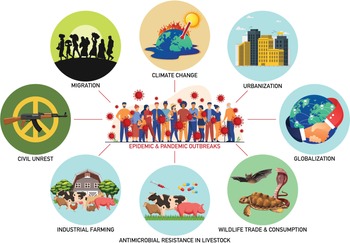To the Editor—Since the outbreak of coronavirus disease 2019 (COVID-19), scientists have been pondering over the causative factors that are essential for infectious diseases to emerge. Many interpret pandemics solely as the result of the expanding human population, but this may be a half truth. The overall choices we make on a political, socioeconomic, and personal level determine the likelihood of the next outbreak to occur (Fig. 1). The major epidemic and pandemic outbreaks of the last few decades were caused by zoonoses. Zoonotic species, especially viruses and protozoa, are twice as likely to emerge in comparison to nonzoonotic species. Reference Taylor, Latham and Woolhouse1 Continuous interactions between humans and wild animals increase the risk of emerging diseases. A study in the Asian-Australasian region revealed that those wild mammals that predominantly harbor emerging pathogens are 15 times more likely to use a human modified environment compared to other wild mammals in the same region. Reference McFarlane, Sleigh and McMichael2 A typical case of this human–animal interface is bushmeat hunting for human consumption, which not only leads to species extinction but also promotes transmission of previously unknown infectious agents to humans. Reference Jones3 Urban wildlife markets are present in many parts of the world, creating pathways for zoonotic diseases to thrive. For example, the probable origin of COVID-19 was a wildlife market in the city of Wuhan, China. Reference Zhang, Wu and Zhang4 Illegal wildlife trade, a profitable business with tremendous financial interests, increases human exposure to wildlife vectors, resulting in the emergence of infectious diseases. Reference Bezerra-Santos, Mendoza-Roldan, Thompson, Dantas-Torres and Otranto5 All of these factors reflect the human greed and ceaseless need for intervention in ecosystems with a single purpose, human benefit.

Fig. 1. Major drivers of the emergence of epidemics and pandemics.
Apart from wildlife trade, deforestation also brings humans closer to the wild and opens the gate for the spread of emerging diseases. Urbanization, land use for industrial farming, monoculture tree plantations, especially for the production of palm oil, and wildfires, which are increasing exponentially due to global warming, all lead to habitat and biodiversity loss. Reference Priyadarsini, Suresh and Huisingh6 This ultimately results in pathogen spillover from wildlife to domestic animals and humans while altering the abundance and distribution of certain disease vectors.
A reigning narrative exists that the consumption of exotic animals represents the sole threat for pandemics to emerge. In reality, the excess consumption of chicken, beef, and pork equally contributes to this problem. To maximize profit from meat production, animals are tightly packed together and specific genes that code for desirable traits (eg, large chicken breasts) are selected. This plethora of genetically identical animals constitutes the perfect environment for a disease to spread rapidly. Additionally, from close confinement to operations done without anesthesia, these animals are subjected to an immense amount of stress that renders them more vulnerable hosts. Reference Jones3 Furthermore, to counteract all the aforementioned unhealthy conditions, the routine use of prophylactic antimicrobials has been adopted in factory farms, a fact that greatly exacerbates the existing issue of antimicrobial resistance. Reference Cheng, Ning and Ahmed7 Numerous examples of zoonoses that originated from meat farms already exist, like the outbreak of Nipah virus in Malaysia in the 1990s and the H1N1 pandemic in 2009. Now, more than ever, it has become evident that by abandoning industrialized farming and returning to a smaller model of raising livestock, we can maintain meat production and simultaneously reduce epidemic and pandemic risk and address the matter of animal welfare.
The eliciting factor of civil unrest is not only human overpopulation but also the innate human desire for dominance. Civil unrest can cultivate a breeding ground for an epidemic or a pandemic to erupt. In the case of the Ebola outbreak, social conflicts in the Democratic Republic of the Congo increased human-to-human transmission and devastated the regional healthcare system. Reference Wells, Pandey and Ndeffo Mbah8 Due to these civil disturbances, there was also a delay in the detection of the epidemic, which was officially declared after it had already spread to neighboring countries. Furthermore, political disorders and civil wars trigger human migration and cohabitation in conditions which are proper for infectious diseases to emerge. Reference Spernovasilis, Siakallis, Tsiodras and Poulakou9 Poor hygiene and sanitation, malnutrition, and difficulties in healthcare supply in refugee camps have caused a lot of epidemic outbreaks during the last decade.
The effects of the anthropogenic alteration of ecosystems along with the continuous pursuit of profit are now indisputably linked to infectious disease emergence. Although we tend to portray ourselves as the victims of pandemics, in truth we are the facilitators. Drastic and decisive measures that address the aforementioned issues on a global level are urgently needed. The sooner we comprehend that “planetary health” and human health are entirely interconnected, the sooner we can start rebuilding the fundamental relationship between us and nature.
Acknowledgments
We thank Mr. Ognyan Iskrenov for assistance in preparing Figure 1.
Financial support
No financial support was provided relevant to this article.
Conflicts of interest
All authors report no conflicts of interest relevant to this article.




